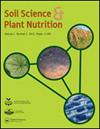低植酸大豆系植酸合成基因肌醇-1,3,4三磷酸5/6激酶的异常RNA剪接
IF 1.8
4区 农林科学
Q3 ENVIRONMENTAL SCIENCES
引用次数: 1
摘要
大多数磷以植酸的形式储存在植物种子中,尽管它被认为是一种抗营养化合物,会降低单胃动物对矿物质的生物利用度。低植酸作物提高了单胃动物体内矿物质的生物利用度,减少了磷对环境的污染。最近,我们报道了一个由LP系CX1834与日本普通植酸品种Natto-kotsubu (Natto)杂交而成的LP大豆新品系,与CX1834相比,该品系在出苗、生长和产量方面均表现出优越的性状。LP系中LP性状的分子机制尚不清楚。将LP系用于从头RNA- seq分析,我们发现LP系中植酸合成酶基因肌醇-1,3,4三磷酸5/6激酶3 (GmITPK3)的RNA剪接异常。研究植酸生物合成相关基因的表达水平和肌醇磷酸异构体浓度。从头RNA-Seq分析显示,GmITPK3的内含子保留(IR)转录本在LP株系的叶片中高度表达。虽然两者都表达,但LP系中多个IR转录本的相对丰度显著高于纳豆品种。编码截断蛋白的GmITPK3的IR转录本缺少其活性的必要结构域,而其中一个可能包含异常的配体结合位点。在种子发育过程中,LP系IR转录本的相对丰度是纳豆品种的1.9 ~ 5.4倍;因此,LP系发育中的种子中植酸及其前体的产量低于纳豆品种。在LP系GmITPK3发生剪接错误的外显子-内含子连接处未检测到突变,这意味着剪接错误归因于参与GmITPK3剪接调控的未知剪接因子基因。我们的研究结果提供了对GmITPK3剪接错误可能参与LP系低植酸产生特性的见解。本文章由计算机程序翻译,如有差异,请以英文原文为准。
Aberrant RNA splicing of the phytic acid synthesis gene inositol-1,3,4 trisphosphate 5/6-kinase in a low phytic acid soybean line
ABSTRACT Most phosphorus is stored as phytic acid in plant seed, although it is considered an anti-nutrient compound that reduces the bioavailability of minerals in monogastric animals. Low-phytic acid (LP) crops improve mineral bioavailability in monogastric animals, which can decrease environmental pollution due to phosphorus. Recently, we reported a newly developed LP soybean line by crossing the LP line CX1834 and Japanese normal phytic acid cultivar Natto-kotsubu (Natto), which showed superior traits in seedling emergence, growth, and yield compared with CX1834. The molecular mechanism underlying the LP trait in the LP line remains unclear. The LP line was used for a de novo RNA-Seq analysis, and we illustrated the aberrant RNA splicing of the phytic acid synthase gene inositol-1,3,4 trisphosphate 5/6-kinase 3 (GmITPK3) in the LP line. The expression level of phytic acid biosynthesis-related genes and inositol phosphate isomer concentrations were investigated. A de novo RNA-Seq analysis revealed that the intron retention (IR) transcript of GmITPK3 is highly expressed in the leaves of the LP line. Although expressed in both, the relative abundances of multiple IR transcripts were significantly higher in the LP line than that in the Natto cultivar. The IR transcripts of GmITPK3 encoding truncated proteins were missing an essential domain for their activity, while one possibly contained an abnormal ligand binding site. The relative abundance of IR transcripts was 1.9- to 5.4-times higher in the LP line than that in the Natto cultivar during seed development; accordingly, the production of phytic acid and its precursors in the developing seeds was lower in the LP line than that in the Natto cultivar. No mutation was detected at the exon–intron junction, where a splicing error occurs in GmITPK3 of the LP line, implying that a splicing error is attributed to unknown splicing factor genes involved in the splicing regulation of GmITPK3. Our results provide insights into the possible involvement of splicing errors in GmITPK3 for the trait of low phytic acid production in the LP line.
求助全文
通过发布文献求助,成功后即可免费获取论文全文。
去求助
来源期刊

Soil Science and Plant Nutrition
农林科学-农艺学
CiteScore
4.80
自引率
15.00%
发文量
56
审稿时长
18-36 weeks
期刊介绍:
Soil Science and Plant Nutrition is the official English journal of the Japanese Society of Soil Science and Plant Nutrition (JSSSPN), and publishes original research and reviews in soil physics, chemistry and mineralogy; soil biology; plant nutrition; soil genesis, classification and survey; soil fertility; fertilizers and soil amendments; environment; socio cultural soil science. The Journal publishes full length papers, short papers, and reviews.
 求助内容:
求助内容: 应助结果提醒方式:
应助结果提醒方式:


